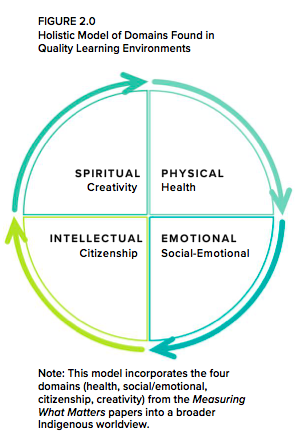What is my role in providing a quality learning environment? When we take a look at the factors that affect indigenous students and their learning like the table below it may seem overwhelming in determining where you fit as an educator.
Table 1.0: Factors Affecting Indigenous Students and Their Learning
Classroom features | Teacher communities |
| Diversity and differentiated learning is foundational Learning is linked to students’ lives and experiences High expectations for all student coupled with differentiated assessment Classroom management is focused on community building and relationships | Professional development is ongoing where data is a critical feature Time and resources are allotted for teachers to plan together Relationships are collegial and student learning, as well as community, is a key underpinning Teachers are valued for their work and commitment |
Schools & climate | External environment |
| School safety for all is a priority Interpersonal relationships are positive and evolving Teaching and learning practices are evidence based Organizational structures support vision of inclusion Shared leadership is the reality between admin and staff Deconstructing the hidden curriculum | Parental and community engagement plans honour difference Culminating tasks for students are rooted in social change in the community Community and school events are integrated, shared and seamless Global citizenship and environmental stewardship connections |
Note. This table is a summary of the areas in Bascia’s paper that complement the diverse perspectives of Indigenous peoples regarding student achievement.
Classroom features, teacher communities, school climate and the external environment are broad concepts that are strongly interconnected. Learning outcomes, especially when more holistic definitions and interpretations are being considered, will be directly affected by these factors (Ontario Ministry of Education, 2014). [1] Indigenous ways of learning are part of that diversity and cannot be integrated if teacher professional development is inconsistent and there is limited time for collaborative planning. Also, the absence of parental engagement plans and linkages to community resources for Indigenous families become further barriers for students’ rightful attainment to balance/wellness. [1] We need all these pieces to fit together to make it work. These complex issues will require solutions in a multifaceted approach and we have to have measures of success.What is a quality learning environment? How do Indigenous worldviews reflect this concept? Are there particular components that make up this type of teaching/learning setting?
When we integrate and truly embed indigenous pedagogy, relevant curriculum content and the medicine wheel we are all components of student success and a quality learning environment.
